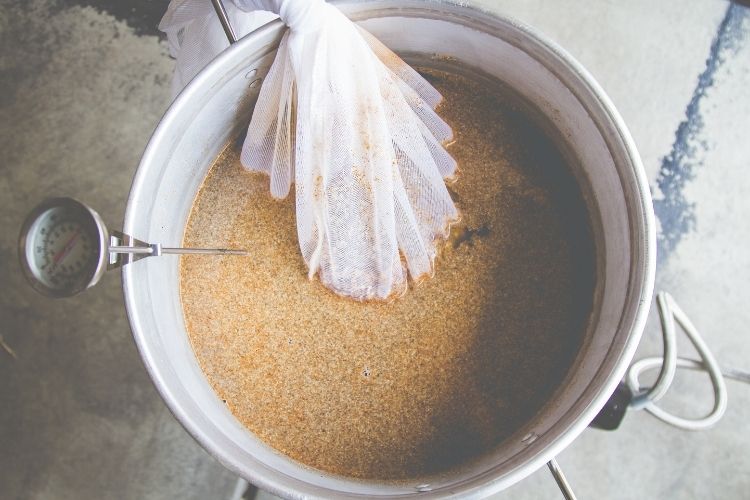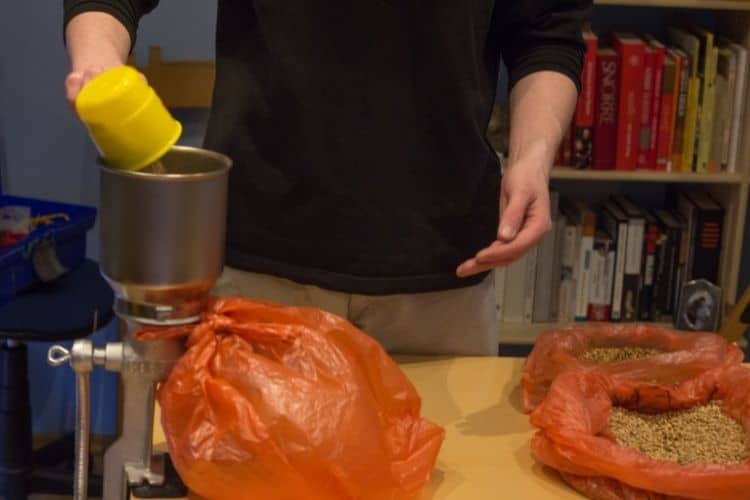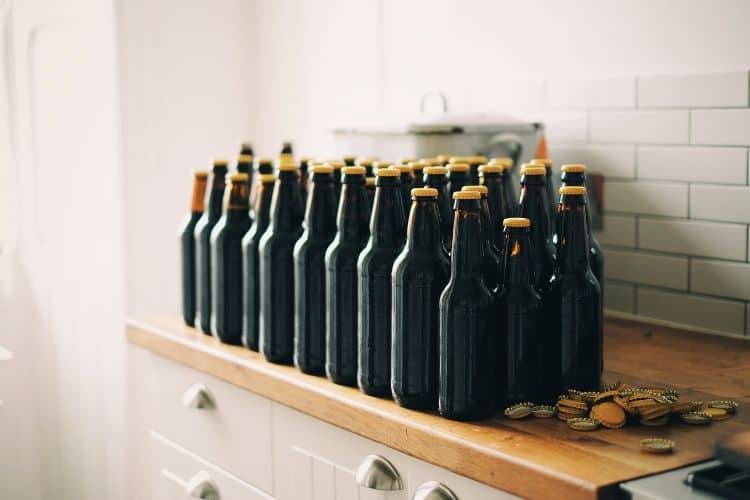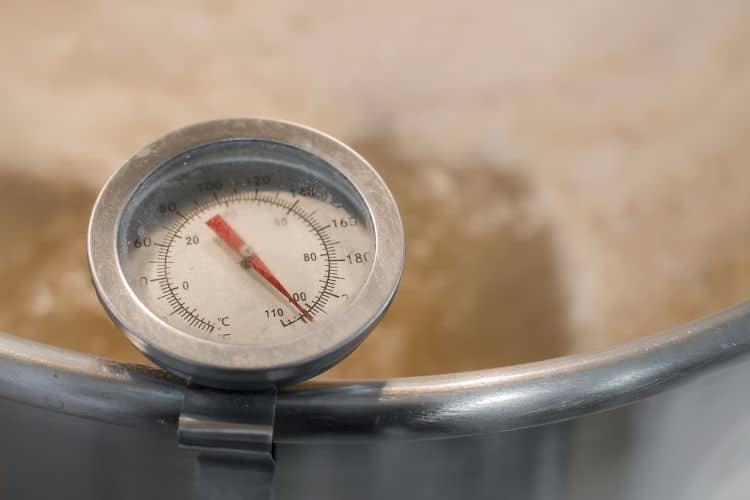- Rye Malt Guide – How to Use This Malt for Distinctive Homebrews - November 24, 2022
- Aromatic Malt Guide – Why I Use This Malt in My Homebrew Recipes - November 19, 2022
- Willamette Hops Guide – Why I’m a Fan of This Classic American Hop - November 9, 2022
When you enter into the wonderful world of homebrewing, your first question will likely be ‘how do I get started?’ or ‘what equipment do I need?’. Any sort of guide or list that gives you this information will likely be littered with all kinds of phrases and terminology you might not have encountered before.
If you’re feeling overwhelmed by the vast amount of different homebrewing terms, and are looking for an explanation, then you’ve come to the right place.
Here, we’ll save you some time and take you through some of the homebrewing terms you’ll likely come across and explain what they mean.
A
Acetic acid – an acid that is produced by various yeasts and bacteria. It smells and tastes a bit vinegary, and can end up ruining your homebrew.
ABV (Alcohol By Volume) – this is the measurement of how strong your homebrew is. You’ll often see it written in a percentage form, which basically equates to the milliliters of alcohol per 100g of beer.
Ale – the name for a beer brewed by top fermentation, often without hops.
Airlock – a one-way valve that allows carbon dioxide to escape but doesn’t let any microbes or bacteria in. We’d recommend this twin pack of airlock bungs.
Alpha acid – the acid resin that is responsible for the bitterness you can find in beer.
Attenuation – the official name for the degree of the conversion of sugar to alcohol and carbon dioxide.
Aeration – the exposure of your homebrew to air, which is often done throughout the brewing process.
All-grain brewing – when you create a beer using only malted grains rather than malt extract.
Adjuncts – unmalted grains that are used to supplement the main mash ingredient.
B

Bacteria – tiny organisms that can either add or destroy flavor to your homebrew.
Barley – one of the principal grains used in homebrewing.
Body – a way of describing the consistency, thickness, and sensation of the homebrew when you drink it.
Bottle-conditioned – this is when the beer is carbonated naturally in the bottle either by re-yeasting it or priming it.
Beer – any beverage produced by fermenting sugars from different grains. They are usually distinguished through their balance of bitterness and sweetness.
Boil – a step in the homebrewing process when you transfer the sweet wort to a kettle and boil it with hops to create a bitter wort.
Bitter – a type of beer predominantly associated with England, renowned for its maltiness, fruitiness, and bitterness.
Barm – a form of liquid yeast that sometimes appears as foam on fermenting beer.
Brightness/Brilliancy – the description given to a clear and effervescent beer – often a very fresh beer that can be served immediately.
Bottle capper – pieces of equipment used to put the caps on your bottles. Get yourself a bottle capper if you need one.
Brewing kettle – a pot, usually made of stainless steel, used to boil the beer in preparation for fermentation. We recommend the GasOne 64QT if you’re in the market for a brewing kettle.
C
Conditioning – part of the secondary fermentation process where the yeast refines the flavors of the final beer. Conditioning also takes place in the bottle.
Casks – cylindrical receptacles for dispensing beer that were traditionally made out of wood but nowadays are made out of steel.
Carbhttps://beertannica.com/homebrewing/best-gallon-glass-carboy-for-brewing/oy – a large glass or plastic jar with a narrow spout that is traditionally used for fermentation. Try out this carboy and get your homebrewing started!
Carbonation – the process of adding carbon dioxide to make your homebrew bubbly.
Carbon dioxide – a colorless gas that is a by-product of fermentation along with alcohol.
D
Draft/Draught – beer that’s poured, or drawn, from casks, kegs, or barrels, instead of being bottled.
Distillation – the process of heating a liquid to boiling point, condensing the vapors given off, and collecting them. Frequently a method of extracting alcohol.
Disinfecting – an essential part of the homebrewing process, where you make sure that all your equipment is cleaned to avoid rogue bacteria that might damage your beer. One of the best disinfectants that we can recommend is the Five Star 1 No Rinse Sanitizer.
Dry-hopping – the process of adding dry hops to the finished beer, in order to increase the flavor of the beer without making it too bitter.
Doubling – when you add unyeasted wort to your homebrew in the initial stages of fermentation.
Diacetyl – an aroma that is derived from yeast which can give your homebrew a butterscotch or a buttery flavor.
Demijohn – similar to a carboy. A glass or plastic vessel with a narrow neck that is used for homebrewing. Must be used with an airlock. Check out this FastRack demijohn with airlock if you’re looking for a demijohn.
Doughing – the first step in all-grain brewing, where you mix ground malt with water.
Decoction – when you remove some of the mash, boil it, and return it to the main kettle to boost the overall temperature of the mash. This method is primarily used in all-grain brewing.
E

Enzyme – found in malt, enzymes help with fermentation.
Extract – the solids that are contained in the liquid (such as wort).
Ester – the by-product of acid and alcohol reacting. These contribute a fruity flavor to your homebrew.
Effervescence – the bubbles that you can get in beer, as caused by carbon dioxide.
Ethanol – the type of alcohol that is produced by yeast and malt sugar that is found in beer.
Extract brewing – when you use malt extract syrup or powder in your homebrew instead of unprocessed malt (which is often used in all-grain brewing).
F
Fermentation – the process of yeast breaking down sugar and turning it into alcohol and carbon dioxide.
Filtration – when you remove any solids such as yeast and proteins from your beer to produce a bright or brilliant beer. This is usually done just before bottling.
Foam – when a beer is dispensed, it’ll often end up with a froth on top of it. High levels of protein and bitterness will increase the foam levels.
Fermenter – where the magic happens! Usually a large vessel made of plastic. You can also use a carboy or a demijohn. This 2-gallon Plastic Fermenter should fit the bill for any homebrewer, from beginner to advanced.
Fermentation lock – the same as an airlock – a bung that lets carbon dioxide escape but stops any bacteria getting in. Check out these fermentation locks from Box Brew.
Ferulic acid – a compound that is released by malt, and is often seen as an important hallmark of wheat beers, but can be considered as an off-putting flavor when found in normal beer.
Filler – the device used for pouring the beer into bottles or other vessels.
Fining – the way you clarify and settle your homebrew. Traditionally, beer was passed through fish intestines to fine it!
G
Gelatin – a protein that is sometimes used for fining beer.
Grist – the total amount of ground malt and adjuncts that are added to hot water for mashing.
Gushing – the release of gas and beer from a bottle. This often happens when the beer has been over-carbonated.
Growler – containers that are used in pubs and bars to carry quantities of beer. They’re not essential, but we reckon that these FastRack Growlers look the business.
Glucose – the most basic sugar molecule there is.
Gypsum – a calcium-based salt that is sometimes added to the grist to treat soft or neutral water and make it hard. Stock up on this 1lb bag of gypsum.
H

Hops – one of the main ingredients of beer, which gives beer a bitterness.
Head – another name for the foam found at the top of a poured beer.
Hydrometer – a glass instrument used to measure the gravity of the beer, as compared to the gravity of water. You won’t do better than getting your hands on this Brewer’s Elite Hydrometer.
Heat exchanger – an instrument that is used to cool or heat up the wort. Try out our favorite Homebrew Wort Chiller, and step up your brewing prowess.
Hop Bitterness Unit (HBU) – this is the official standardized value assigned to hops to identify how bitter it is, and gives the brewer the ability to calculate the amount of hops to use.
Hopback – a vessel that is filled up with hops in order to act as a filter for the finished wort.
I
International Bitterness Unit (IBU) – an internationally standardized unit of measurement to work out the bitterness of a beer.
Isinglass – a substance that is found in sturgeon fish intestines and is used for fining.
India Pale Ale (IPA) – a classic English beer that is now popular the world over. Light, not too bitter, and not too alcoholic, it’s a great beer for homebrewing.
Infusion mashing – an English method of mashing that is usually used when brewing ale.
Iodine test – a test to check on whether all the starch has degraded. Iodine will turn from yellow to blue or purple if there are any starches present, but will not change color with sugars.
Isohumulones – forms of acid created by hops. The isohumulone content is directly related to how bitter the beer is.
Irish moss – a type of seaweed that is often added at the end of the boiling process for fining.
K
Keg – a straight-sided, pressurized container for dispensing beer.
Kegging – transferring beer from the fermenter to the keg.
Kettle – the name of the metal vessel used to heat the wort.
Krausen – the name for the foamy head that builds up on the surface of the beer during fermentation.
Kiln – a furnace designed for drying materials, such as hops.
L
Lager – a type of beer that is matured for long periods at colder temperatures. The direct German translation of ‘lager’ is ‘storage’.
Lactic acid – an acid produced by yeasts and bacteria during mashing or fermentation.
Lauter – to separate the wort from the spent grains during mashing.
Lambic – a Belgian wheat beer that uses airborne yeast and bacteria to ferment the wort.
Leaching – the removal of dissolvable solids from insoluble solids. Occurs during mashing.
Lovibond – the scale that is used to evaluate malt, wort, and the color of your beer.
Liquid malt extract – malt extract in liquid form, often very thick and requires heating before use. Get your hands on this 32lb growler of Briess Liquid Malt Extract – you’ll be sorted for a while!
Lupulone – bitter resin found on the buds of the hop plants, which can give a slightly spiced flavor to your beer.
M

Malt – grain that has been steeped in water to soften it, and then dried. One of the key ingredients for beer.
Malt extract – wort that has been concentrated into a syrup or a powder after most of the water has been removed. Briess make this great Dry Malt Extract – stock up today.
Mash – a mixture of malted grains and hot water which produces wort, an essential part of the brewing process.
Mash tun – a vessel used to hold the mash. Often used in infusion brewing.
Milling – the process of grinding the malt into grist before mashing.
Maltotriose – a sugar produced by malting, which is fermentable by most brewing yeasts.
Mead – an alcoholic drink made by fermenting honey.
N
Nitrogenation – the addition of nitrogen gas to beer to make it smoother.
Natural conditioning – secondary fermentation that happens as a result of aging.
Nonhopped – any beer or malt extract that hasn’t had any contact with hops.
Nose – a term used in tastings to describe what the beer’s aroma and fragrance is like.
Ninkasi – the Sumerian goddess of beer. Be sure to say a prayer when you start homebrewing!
O
Oxidized – when your brew is exposed to too much oxygen. This can affect the flavor and ruin your beer.
Over-priming – when you add too much sugar to your beer when bottling can cause an over-carbonated brew or even exploding bottles.
Oktoberfest – a legendary German beer festival that features bespoke beers brewed especially for the event.
Original gravity – the gravity of the wort, pre-fermentation.
Off-flavor – a term to describe inconsistent flavors in your beer.
P
Pale ale – a light-colored beer made with pale malt and flavored with hops.
Pilsner – a light, hoppy beer originating from Czechoslovakia.
Porter – an extremely dark and rich beer that originated in London.
Priming – the process of adding a small amount of sugar to the bottles in order to reintroduce fermentation and carbonate the beer.
Primary fermentation – the very first phase of fermentation where sugars are converted into alcohol and carbon dioxide.
Pasteurization is a method of exposing the brew to high heat used to kill microorganisms and lengthen shelf-life.
Pitching – the process of adding yeast to wort.
Protease – an enzyme often used to chill-proof beer when stored in the cellar.
Q
Quinones – oxidizing agents that can produce stale flavors in the wort.
R

Rack – to move beer from one container to another. Often this is an opportunity to separate the beer from any remaining solids.
Real ale – a traditional English ale.
Racking cane – a tube that is used to rack beer that helps leave sediment behind.
Recirculating Infusion Mash System (RIMS) – a type of homebrewing system used by many homebrewers.
Roasted barley – an unmalted barley that is roasted in a kiln, giving it a dark, bitter flavor.
Runoff – another name for wort – effectively the liquid that you separate from the grains when you lauter the beer.
S
Secondary fermentation – when the beer is allowed to settle and condition before bottling.
Saison – a classic, fruity Belgian beer that involves significant conditioning.
Smoked malt – a type of smokey-flavored malt.
Sediment – the solid material that is a by-product of fermentation.
Sparge – the process of spraying the spent grains with hot water to extract the remaining sugars during the mashing process.
Slack malt – malt that has absorbed too much water and has become stale.
Stout – another strong, dark, rich English beer, designed to be more alcoholic than porter.
Siphon – similar to a racking cane, this piece of kit is used to siphon your homebrew from one container to another. Often known as an auto-siphon, get your own siphon here.
Skimming oar – a tool that is used to remove the top layer of yeast that forms at the top of the homebrew during primary fermentation.
T
Tap – attached to a keg or a cask to dispense and control the flow of your beer. Wow your friends and fellow homebrew aficionados with this slick Stainless Steel Beer keg Tap.
Tertiary fermentation – fermentation that is carried out in bottles as a direct result of conditioning.
Thermometer – tool for measuring temperature. Brewing thermometers often differ from normal ones in that they don’t contain mercury, in case they break and ruin the homebrew. This KT THERMO Instant Read Dial Thermometer is perfect for all your homebrewing needs.
Topping up – when you add water after primary fermentation or after boiling the wort or extract to decrease the head space and stop any air contamination.
Trub – the solid sediment found at the bottom of the fermenter.
Trappist beer – beer that is specifically brewed in one of the seven monasteries in Belgium or the Netherlands, renowned for their fruity flavors and their high carbonation.
Tripel – another Belgian beer that is light in color and usually much stronger than standard beer.
Top fermentation – a method of fermentation that uses yeast that stays near the surface. Ales, for instance, are ‘top fermented,’ whereas lagers are ‘bottom fermented.’
U

UK gallon – an imperial gallon, which is the equivalent to around 1.2 US gallons. The UK sizing of pints are also greater than the US.
Unload – the process of emptying steeped malts from the steeping vessel.
Unitank – a fermentation and conditioning vessel that’s commonly used in large-scale beer manufacture.
Ullage – calculation of how much headspace is in the cask, keg, or barrel.
Under modified malt – dry kilned malt where the enzymes can no longer transform into proteins.
Underoxygenated – when the wort has not been sufficiently oxygenated for fermentation. Oxygen is an essential part of the fermentation process.
V
Viscosity – refers to the body of the beer and how it feels when you drink it. Basically, it describes the thickness of the beer.
VGA – an American style of hops that gives homebrew a medium bitterness.
Volatile acid – acids in beer that are decreased through fermentation.
Vat – a large fermentation or storage vessel.
W
Weissbier – a German-style of wheat beer that is usually very pale in color.
Wild yeast – yeast that is usually airborne. Originally all beer was made using wild yeast.
Wort – the solution that is created from boiling malt, hops, and water. When yeast is added to it, it starts to ferment. It is one of the building blocks of homebrewing.
X
Y
Yard of ale – a large glass that is a yard (3 feet) long and usually holds about a quart of beer.
Yeast – another of the building blocks of homebrewing. Yeast converts sugars into alcohol and carbon dioxide during fermentation. Get your hands on this 500g pack of Safale Beer Yeast, and you’ll be brewing for months to come!
Yeast nutrients – if you want to boost your yeast’s health and vitality, try adding some Fermax Yeast Nutrient, and level up your homebrewing prowess.
Yeast crop – yeast that is collecting during or after fermentation.
Z
Zymase – enzymes found in yeast that convert sugars into alcohol and carbon dioxide during fermentation.
Zymology – sometimes called zymurgy, this is the study and science of fermentation.
Zentner – the standard measurement for hops. One zentner is equivalent to 50kg of hops.
Frequently Asked Questions
If you’ve got a question burning a hole in your pocket, we’ll try our best to address it in this selection of the most frequently asked questions about homebrewing.
Question: I’ve seen people talk about the seven steps of brewing. What are they?
Answer: These are a series of steps that can guarantee excellent homebrew. The seven steps are malting, mashing, lautering, boiling, fermenting, conditioning, and packaging.
Question: How long does the process of fermentation take?
Answer: This is the most important step in the homebrewing process, so you don’t want to take any shortcuts with this. Initial fermentation can only take 7 to 10 days, but for fermentation to complete fully, it’ll take 2 to 4 weeks.
Question: Does more yeast mean faster fermentation?
Answer: To a point, this is true, but it could also end up affecting the flavor of your homebrew – especially those glorious fermented flavors that are the hallmark of any good homebrew. You can always try and find yeast that finishes a bit sooner rather than end up adding too much yeast.
Question: How do you know when fermentation is finished?
Answer: You’ll be able to tell when fermentation is finished when the homebrew stops letting off-gas. The airlock in your fermenter will be still and will have reached equilibrium. Though the best way to find out if your brew is ready is by tasting it – probably the most exciting part of the whole process!
Final Thoughts
So there you have it – an A to Z of all the homebrewing terms you might come across explained. If you find yourself puzzled by any terms or words as you start down your homebrewing path, and you’re looking for a suitable explanation, then we have you covered. Swot up on these, and you’ll be sitting back with a cold one in no time at all. Cheers!
